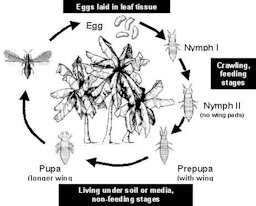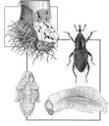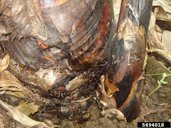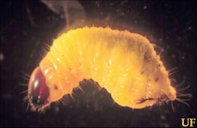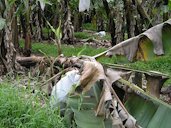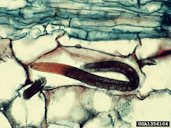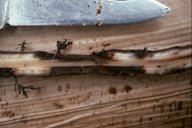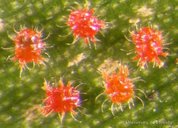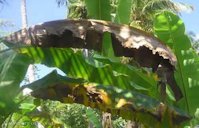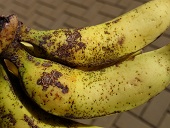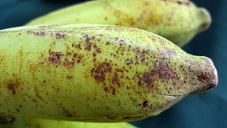| Banana Pests | |||||||||||||||||||||||||||||||||||||||||
|---|---|---|---|---|---|---|---|---|---|---|---|---|---|---|---|---|---|---|---|---|---|---|---|---|---|---|---|---|---|---|---|---|---|---|---|---|---|---|---|---|---|
|
Back to Banana Page 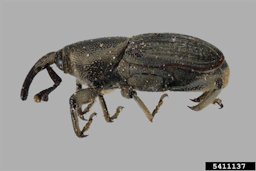 Fig. 1  Banana root borer, Cosmopolites sordidus 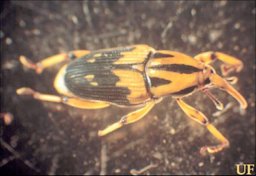 Fig. 8  Color pattern of the adult silky cane weevil, Metamasius hemipterus sericeus  Fig. 11 Lodging banana plants suffering from Toppling Disease caused by the burrowing nematode, Radopholus similis 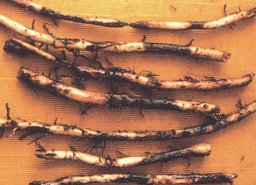 Fig. 12  Burrowing nematode (R. similis) damage to banana roots 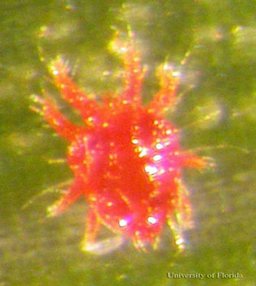 Fig. 18  Adult male red palm mite, Raoiella indica  Fig. 19  Severe damage to palm caused by the red palm mite, R. indica 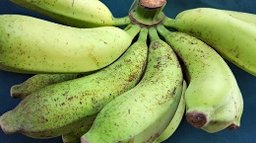 Fig. 22  Banana: thrips feeding injury to fruits
 Life cycle of the banana rust thrips
|
Banana Root Borer Cosmopolites sordidus (Germar) The banana borer lays eggs at the base of the pseudostem and the larvae bore into the pseudostems and rhizome causing extensive damage. Young plants may be killed by extensive tunneling and mature plants may weaken and topple with a subsequent reduction in yield. Control of the pest includes use of clean (non-infested) planting material and sanitation (removal and/or grinding up old pseudostems). For more information, please contact your local Cooperative Extension Agent. 4
Fig. 2. Banana root borer Fig. 3. Banana C. sordidus larva Fig. 4. Life cycle of the banana root borer: clockwise from top right, adult, larva, pupa, and tunnels in the banana corm Fig. 5,6. Banana root borer damage Fig. 7. Corm weevils (C. sordidus) injury to basal pseudostem
Further Reading Banana Root Borer, Cosmopolites sordidus (Germar), University of Florida pdf Silky cane weevil Metamasius hemipterus sericeus (Olivier) The silky cane weevil causes similar damage and problems as the banana weevil. The larvae tunnel into the pseudostem, building galleries that weaken the plant. For more information, please contact your local Cooperative Extension Agent. 2
Fig. 9. Larva of the silky cane weevil Fig. 10. Damage to sugarcane by the silky cane weevil Further Reading Silky Cane Weevil, Metamasius hemipterus sericeus (Olivier), University of Florida pdf Nematodes Burrowing Radopholus similis Symptoms of burrowing nematode are most readily observable as dark and necrotic lesions on the root system, similar to those caused by pathogenic fungi, Helicotylenchus multicinctus, and other endoparasitic nematodes that may infect banana roots. Root systems can become stunted, unthrifty, and necrotic. In banana, lesions may be present in both the roots (Fig. 12) and outer layer of the rhizome. Feeding of the burrowing nematode causes extensive damage to the root system and rhizome of banana. The spiral nematode causes extensive damage to the fibrous root system. Injured plants are susceptible to invasion by pathogens and toppling. Purchase and use of non-infested plant material (tissue culture plants, suckers or rhizomes) is the best control. If possible inspect the root system and base of the sucker for dead roots prior to purchasing. For more information, please contact your local Cooperative Extension Agent. 4
Fig. 13. Corm necrosis caused by the burrowing nematode Fig. 14. Toppling due to R. similis Fig. 15. Toppling of banana; in this case, the root system was infected with root-knot nematodes (Meloidogyne sp.) and/or burrowing nematodes (R. similis) and thereby compromised, necrotic and/or galled, shallow and weakened, the plant was bearing a bunch, and there was a rain storm bearing high winds Fig. 16. Section of ginger infected with R. similis Fig. 17. Banana roots infected by R. similis, note dark lesions and necrotic roots induced by the nematode feeding and tunneling Further Reading Banana Nematodes, American Samoa Community College, Cooperative Research and Extension pdf Burrowing Nematode, Radopholus similis (Cobb, 1893) Thorne, 1949, University of Florida pdf Red Palm Mite Raoiella indica Hirst Until recently, the Red Palm Mite pdf was found in India, Egypt, Israel, Mauritius, Reunion, Sudan, Iran, Oman, Pakistan, and the United Arab Emirates. However, in 2004, this pest was detected in Martinique, Dominica, Guadeloupe, St. Martin, Saint Lucia, Trinidad, and Tobago in the Caribbean. In November 2006, this pest was found in Puerto Rico. In 2007, the red palm mite was discovered in Florida. As of April 2009, this pest was in five counties: Broward, Miami-Dade, Martin, Monroe, and Palm Beach (FDACS 2009). It is spreading rapidly and is expected to establish in other subtropical regions of the Western Hemisphere. This mite is easily distributed by wind currents and movement of infested plants through nursery stock and cut branches of plants. It is likely to establish throughout tropical and subtropical areas throughout the Western Hemisphere. 5
Fig. 20. Adult females of the red palm mite Fig. 21. Symptoms/damage on banana leaves Further Reading Red Palm Mite, Raoiella indica Hirst, University of Florida pdf Banana Rust Thrips Chaetanaphothrips signipennis On banana, feeding damage is observed on the pseudostem, but it is the injury to the fruit that significantly affects marketability Thrips feeding in leaf sheaths results in characteristic dark, V-shaped marks on the outer surface of leaf petioles. Damaged tissue becomes bronzed or rust-colored with age. Feeding damage to the fruit occurs on fingers soon after the flower petals dry, initially typified by a water-soaked appearance. Young fruits may have dark, smokey-colored random squiggle or curlicue feeding tracks on the surface. On mature fruit, oval-shaped, reddish “stains” may be seen where the fingers touch. Extensive damage may cover more of the fruit surface with reddish-brown or black discoloration and superficial cracks. Though unmarketable, such fruits are still edible. 6
Further Reading Banana Rust Thrips Damage to Banana and Ornamentals in Hawaii, University of Hawai'i at Mānoa pdf |
||||||||||||||||||||||||||||||||||||||||
| Bibliography 1 Woodruff, Robert E., and Thomas R. Fasulo. "Banana Root Borer, Cosmopolites sordidus (Germar) (Insecta: Coleoptera: Curculionidae)." Entomology and Nematology Department, UF/IFAS Extension, EENY-391, Original pub. Oct. 2006, Revised Aug. 2015, Oct. 2021, AskIFAS, edis.ifas.ufl.edu/in706. Accessed 6 Jan. 2018, 9 Oct. 2020, 6 Mar. 2023. 2 Weissling, Thomas J., et al. "Silky Cane Weevil, Metamasius hemipterus sericeus (Olivier) (Insecta: Coleoptera: Curculionidae)." Entomology and Nematology Department, UF/IFAS Extension, EENY-053, Original pub. Sept. 1998, Revised Aug. 2007, Aug.2010, Sept. 2013, and Jan. 2017, Reviewed Apr. 2020, AskIFAS, edis.ifas.ufl.edu/in210. Accessed 6 Jan. 2018, 9 Oct. 2020, 6 Mar. 2023. 3 Sekora, Nicholas, and William T. Crow. "Burrowing Nematode Radopholus similis (Cobb, 1893) Thorne, 1949 (Nematoda: Secernentea: Tylenchida: Pratylenchidae: Pratylenchinae)." Entomology and Nematology Dept., UF/IFAS Extension, EENY-542, Original pub. Oct. 2012, Reviewed Nov. 2018, AskIFAS, edis.ifas.ufl.edu/in969. Accessed 15 Mar. 2017, 9 Oct. 2020. 4 Crane, Jonathan H., and Carlos F. Balerdi. "Bananas Growing in the Home Landscape." Horticultural Sciences Dept., UF/IFAS Extension, HS10, Original pub. Oct. 1971 as FC-10, Revised Jan. 1998, Dec. 2005, Oct. 2008, and Nov. 2016, Reviewed Dec. 2019, AskIFAS, edis.ifas.ufl.edu/mg040. Accessed 24 Mar. 2017, 3 Aug. 2020. 5 Hoy, Marjorie A., et al. "Red Palm Mite, Raoiella indica Hirst (Arachnida: Acari: Tenuipalpidae)." Entomology and Nematology Dept., UF/IFAS Extension, EENY-397, Original pub. Nov. 2006, Revised Apr. 2010, Aug. 2015, and Feb. 2019, July 2022, AskIFAS, edis.ifas.ufl.edu/in711. Accessed 15 Mar. 2017, 9 Oct. 2020, 6 Mar. 2023. 6 Hara, Arnold H., et al. "Banana Rust Thrips Damage to Banana and Ornamentals in Hawai'i." Insect Pests, June 2002, IP-10, Department of Plant and Environmental Protection Sciences, Hawai'i Department of Agriculture, CTAHR, www.ctahr.hawaii.edu/oc/freepubs/pdf/IP-10.pdf. Accessed 7 May 2018. Video Crane, Johathan H., and Ian Maguire. "Banana Series, banana root borer." University of Florida, IFAS/TREC. Photographs Fig.1,2 Giron, Duque, Jennifer C. "Banana root borer, Cosmopolites sordidus (Germar, 1824)." University of Puerto Rico, 2010, Bugwood.org, bugwood.org. Accessed 19 March 2014. Fig. 3 Nelson, Scot C. "Cosmopolites sordidus in Hawai'i." Flickr, 2005, (CC BY 2.0), flickr.com. Accessed 15 Mar. 2017. Fig. 4 McCormack G. "Cosmopolites sordidus, Banana-root Borer." Cook Islands Biodiversity Database, Version 2006.1, Cook Islands Natural Heritage Trust, Rarotonga, 2006, cookislands.bishopmuseum.org. Accessed 15 Aug. 2014. Fig.5,6 Brito, Oswaldo. "Banana Root Borer Damage." Independent Consultant, 2013, Bugwood.org, bugwood.org. Accessed 19 March 2014. Fig.7 Nelson, Scot C. "Banana: Corm weevils (Cosmopolites sordidus) injury to basal pseudostem." Flickr, 2016, (CC BY 2.0), flickr.com. Accessed 15 Mar. 2017. Fig. 8,9,10 Giblin-Davis, Robin M. "Larva of the silky cane weevil, Metamasius hemipterus sericeus (Olivier)." Entomology and Nematology Dept., University of Florida, AskIFAS, entnemdept.ufl.edu. Accessed 15 Aug. 2014. Fig. 11 Coyne, Danny. "Banana Root Borer Radopholus similis." Consultative Group on International Agricultural Research, AskIFAS, entnemdept.ufl.edu. Accessed 15 Aug. 2014. Fig.12 Nelson, Scot C. "Burrowing nematode (Radopholus similis) damage to banana roots." Flickr, 2004, (CC BY 2.0), flickr.com. Accessed 15 Mar. 2017. Fig.13 Nelson, Scot C. "Corm necrosis caused by the burrowing nematode." Flickr, flickr.com. (CC BY 2.0). Accessed 15 Mar. 2017. Fig.14 Nelson, Scot C. "Banana: Toppling due to Radopholus similis." Flickr, 2004, (CC BY 2.0), flickr.com. Accessed 15 Mar. 2017. Fig.15 Nelson, Scot C. "(Radopholus similis) Toppling of banana. In this case, the root system was infected with root-knot nematodes (Meloidogyne sp.) and/or burrowing nematodes and thereby compromised, necrotic and/or galled, shallow and weakened, the plant was bearing a bunch, and there was a rain storm bearing high winds." Flickr, 2006, (CC BY 2.0), flickr.com. Accessed 15 Mar. 2017. Fig. 16 McClure, Michael. "Section of ginger infected with Rhadopholus similis." University of Arizona, 2010, Bugwood.org, bugwood.org. Accessed 15 Aug. 2014. Fig. 17 Dunn, Robert. 'Banana Root Borer Radopholus similis." Entomology and Nematology Dept., University of Florida, AskIFAS, entnemdept.ufl.edu. Accessed 15 Aug. 2014. Fig. 18 Duncan, Rita. "Red Palm Mite, adult male, Raoiella indica Hirst (Arachnida: Acari: Tenuipalpidae)." University of Florida, AskIFAS, edis.ifas.ufl.edu. Accessed 15 Aug. 2014. Fig. 19 Pea. Jorge. "Severe damage to palm caused by the red palm mite, Raoiella indica Hirst." University of Florida, AskIFAS, edis.ifas.ufl.edu. Accessed 15 Mar. 2017. Fig. 20 Duncan, Rita. "Adult females of the red palm mite, Raoiella indica Hirst (Arachnida: Acari: Tenuipalpidae)." University of Florida, AskIFAS, edis.ifas.ufl.edu. Accessed 15 Aug. 2014. Fig. 21 Pea. Jorge. "Symptoms of Red Palm Mite on Banana Leaves, Raoiella indica Hirst." University of Florida, 2014, AskIFAS, edis.ifas.ufl.edu. Accessed 15 Mar. 2017. Fig. 22 Nazario-Leary, Cynthia. "Banana: Thrips feeding injury to fruits." University of Hawai'i at Mānoa, 18 June 2016, CTAHR, Public Domain, www.flickr.com/photos/scotnelson/27680937251/in/album-72157668990835260/. Accessed 8 May 2018. Fig. 23 "Life cycle of the banana rust thrips." [Insect drawings from D. Schulz ~1950], Department of Plant and Environmental Protection Sciences, Hawai'i Department of Agriculture, CTAHR, www.ctahr.hawaii.edu/oc/freepubs/pdf/IP-10.pdf. Accessed 7 May 2018. Fig. 24 Nelson, Scot C. "Banana: Thrips feeding injury to fruits." University of Hawai'i at Mānoa, 9 Aug. 2016, CTAHR, Public Domain, www.flickr.com/photos/scotnelson/28875917265/in/album-72157668990835260/. Accessed 8 May 2018. Fig. 25 Nazario-Leary, Cynthia. "Banana: Thrips feeding injury to fruits,." University of Hawai'i at Mānoa, 18 June 2016, CTAHR, Public Domain, www.flickr.com/photos/scotnelson/27755734515/in/album-72157668990835260/. Accessed 8 May 2018. Fig. 26 Nelson, Scot C. "Banana: Red rust thrips injury to fruit." University of Hawai'i at Mānoa, 20 Jan. 2015, CTAHR, Public Domain, www.flickr.com/photos/scotnelson/16142234880/in/album-72157668990835260/. Accessed 8 May 2018. Published 19 Mar. 2014 LR. Last update 7 Mar. 2023 LR |
|||||||||||||||||||||||||||||||||||||||||
